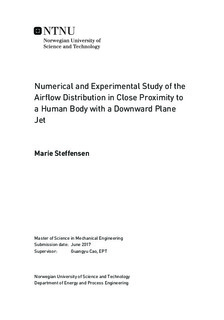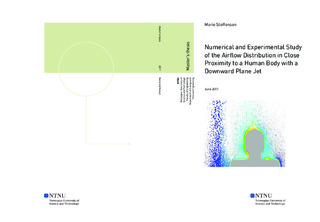| dc.contributor.advisor | Cao, Guangyu | |
| dc.contributor.author | Steffensen, Marie | |
| dc.date.accessioned | 2019-09-11T08:26:29Z | |
| dc.date.created | 2017-06-10 | |
| dc.date.issued | 2017 | |
| dc.identifier | ntnudaim:17299 | |
| dc.identifier.uri | http://hdl.handle.net/11250/2614800 | |
| dc.description.abstract | This study has investigated the airflow distribution close to a thermal manikin situated next to a downward plane isothermal air jet. Three cases have been investigated by experiments in the laboratory, computational fluid dynamics (CFD) simulations and mathematical models. In case 1, airflow characteristics for an isothermal plane jet were investigated. In case 2, airflow characteristics for the thermal plume rising from a thermal manikin were investigated. In case 3, the plane jet and thermal plume interaction were investigated with a thermal manikin at two locations next to the plane jet. Case 3 also explored the draught the manikin would supposedly have felt at the two locations next to the jet. The two locations corresponded to the locations the manikin would experience draught rates of 20% and 10%. The distances from the occupant's shoulder to the jet's centerline have been referred to as comfort distances. The results gained in this study are presented as vector-plots from the simulation, and velocity distribution contour plots, both from experiments and simulations. The experimental results were finally compared to the simulation results and the mathematical models. Neither of the models fitted the experimental results very well, although there was significant correlation in some areas.
The proposed comfort distances have been verified by the experiments and are regarded as the main findings of the draught rate study. The comfort distances were 0.14 m and 0.27 m from centerline of jet to shoulder of manikin, resulting in a draught rate of 20\% and 10\% respectively. The conditions assumed during the deduction of these comfort distances were an ambient air temperature of 23ºC, a plane jet outlet velocity of 1.5 m/s and a metabolic heat rate of 1.2 MET for a sitting thermal manikin next to the jet.
The deduction of comfort distances next to a plane jet for the different comfort criteria of 20% and 10% draught rate can benefit the protected occupied zone ventilation business with valuable recommendations. Additionally, the results presented in this thesis can hopefully be utilized in several other applications, as studies of the human plume and the plane jet were also conducted. | en |
| dc.language | eng | |
| dc.publisher | NTNU | |
| dc.subject | Produktutvikling og produksjon, Energiforsyning og klimatisering av bygninger | en |
| dc.title | Numerical and Experimental Study of the Airflow Distribution in Close Proximity to a Human Body with a Downward Plane Jet | en |
| dc.type | Master thesis | en |
| dc.source.pagenumber | 140 | |
| dc.contributor.department | Norges teknisk-naturvitenskapelige universitet, Fakultet for ingeniørvitenskap,Institutt for energi- og prosessteknikk | nb_NO |
| dc.date.embargoenddate | 2020-06-10 | |

